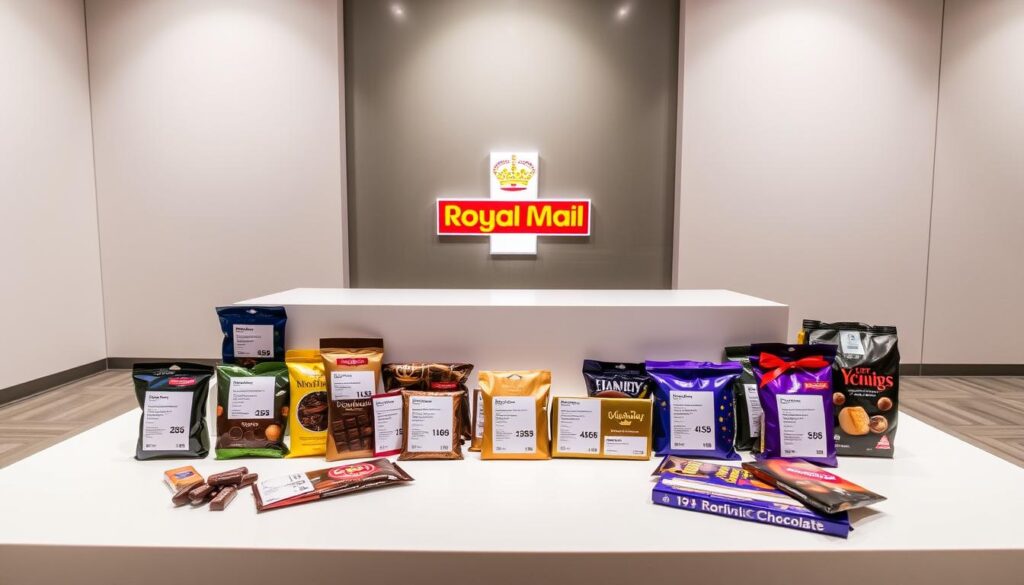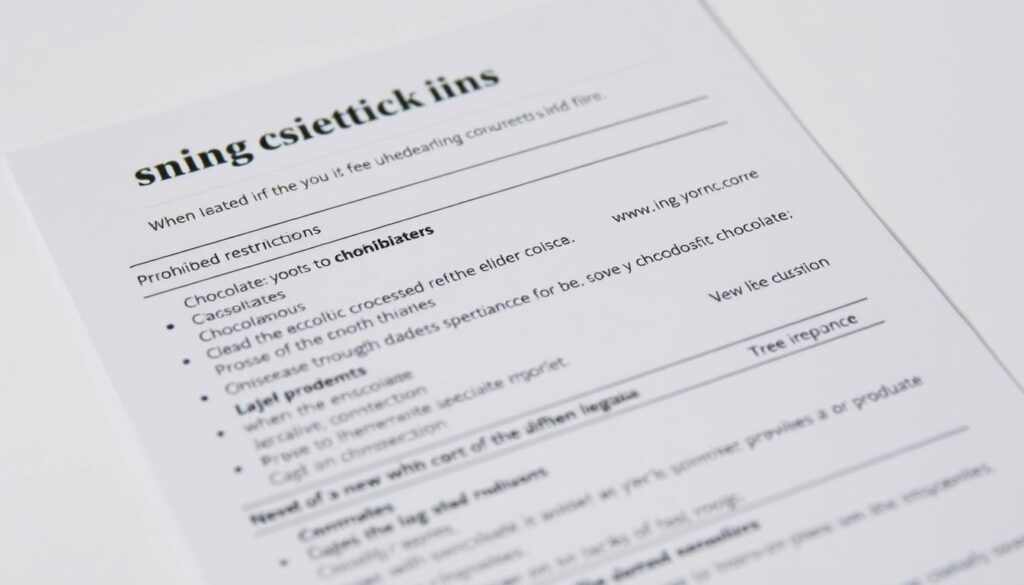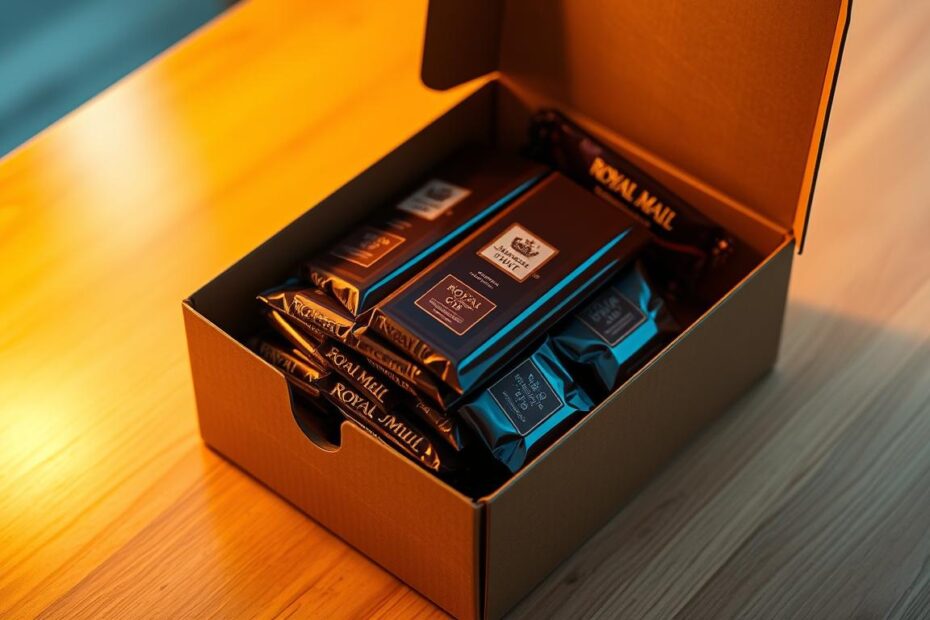Ever thought about sending chocolate to a friend through Royal Mail? It might seem easy, but there are rules to follow. These rules can make shipping chocolate a bit tricky.
Royal Mail has special rules for sending food, like chocolate. Knowing these rules helps your chocolate gift arrive safely. Whether it’s for a birthday or a care package, understanding these rules can save you time and stress.
This guide will help you send chocolate through Royal Mail. We’ll cover packaging and shipping tips. These will ensure your chocolate treats arrive in great shape.
Key Takeaways
- Royal Mail allows chocolate shipping with specific packaging guidelines
- Temperature and packaging are key for safe chocolate delivery
- Different chocolate types need unique shipping methods
- Knowing postal rules avoids shipping problems
- Good packaging keeps chocolate safe during travel
Understanding Royal Mail’s Food Shipping Policies
Sending chocolate by post needs careful planning. You must follow Royal Mail’s shipping rules. This is key for a successful delivery of your sweet gift or treat.
Royal Mail has clear rules for shipping food, like chocolate. These rules help your package arrive safely and in great shape.
Royal Mail Service Overview
There are many options for sending chocolate by post:
- First Class Post
- Second Class Post
- Tracked and Signed services
- Special Delivery Guaranteed
General Food Shipping Guidelines
Royal Mail has special rules for sending chocolate. Here are some important points:
| Chocolate Type | Shipping Considerations |
|---|---|
| Solid Chocolate | Generally easy to ship, requires minimal special packaging |
| Chocolate with Soft Fillings | Needs extra protective packaging to prevent damage |
| Melting Risk Items | Avoid shipping during extreme temperatures |
When sending chocolate by post, make sure your package is:
- Securely sealed
- Appropriately cushioned
- Protected from temperature fluctuations
- Clearly labeled as fragile if necessary
Remember, non-perishable chocolate is easier to ship. Chocolates with cream or fresh fillings might need special care or fast shipping to stay good.
Types of Chocolate You Can Send
When you send chocolate, knowing the types and shipping rules is key. Royal Mail makes it easy to send tasty treats anywhere in the UK.
It might seem hard to mail chocolate, but with the right info, your treats will get there safely and yummy.
Solid Chocolate vs. Chocolate with Fillings
Solid chocolate is the simplest to ship. It stays stable and doesn’t change much with temperature. But, chocolates with fillings need more care:
- Ganache-filled chocolates need extra protection
- Cream-based centers are more sensitive to temperature
- Soft fruit fillings might leak during transit
Considerations for Bulk Orders
Shipping lots of chocolate needs careful planning. Think about these important points for big chocolate shipments:
| Chocolate Type | Shipping Complexity | Packaging Recommendation |
|---|---|---|
| Solid Chocolate Bars | Low | Standard protective wrap |
| Truffles | Medium | Insulated packaging |
| Cream-filled Chocolates | High | Refrigerated shipping |
For big chocolate shipments, pick the right packaging. It should keep the chocolate safe and prevent it from melting or getting damaged on the way.
Required Packaging for Sending Chocolate
When you ship chocolate, you need to pack it right. This keeps your chocolate safe and in good shape. It’s key for sending gifts or running a chocolate delivery service.
Choosing the right packaging is important. You want to protect chocolate from heat, damage, and germs while it’s moving.
Best Practices for Packaging Chocolate
- Use rigid corrugated cardboard boxes for maximum protection
- Wrap individual chocolate pieces in food-grade bubble wrap
- Include gel ice packs for temperature-sensitive chocolates
- Choose insulated shipping containers during warm months
- Seal packages with strong packaging tape
Selecting the Right Box or Envelope
The right container depends on your needs. Small chocolates fit in padded envelopes. But bigger or more delicate ones need strong boxes with padding.
Think about these things when picking your packaging:
- Chocolate type (solid vs. filled)
- Shipping distance
- Expected temperature conditions
- Total weight of chocolate package
Pro tip: Always add insulation and padding. This keeps chocolate from breaking or melting. Your careful packing shows you care and makes customers happy.
Shipping Times: How Long Will It Take?
Sending chocolate through Royal Mail needs careful planning. You want it to arrive in perfect condition. Knowing the shipping times helps you choose the best option.
Royal Mail has many delivery options. Your choice depends on how fast you need your chocolate to arrive.
Standard Delivery Timeframes
For most domestic shipments, you can expect these delivery windows:
- First Class: 1-2 business days
- Second Class: 2-3 business days
- Standard Parcel: 3-5 business days
Express Shipping for Chocolate Lovers
When time is urgent, Royal Mail suggests express services. These ensure your chocolate arrives quickly and safely:
- Royal Mail Tracked 24: Guaranteed next-day delivery
- Royal Mail Tracked 48: Two-day guaranteed delivery
Pro tip: In warmer months, pick faster shipping to avoid melting. Your recipient will thank you for choosing the right option.
Temperature Considerations When Sending Chocolate
When you ship chocolate, you must control the temperature. This keeps your chocolate in top shape. Chocolate gets damaged easily by changes in temperature.
It’s key to know about temperatures when you send chocolate. Chocolate stays best between 55-68°F (13-20°C). Keeping it in this range is vital for shipping.
Navigating Hot Weather Challenges
Summer can be tough on chocolate shipments. Here are some ways to keep your chocolate safe:
- Use insulated packaging with gel ice packs
- Select expedited shipping during warm months
- Choose overnight or two-day shipping options
- Avoid shipping on weekends when packages might sit idle
Cold Weather Shipping Strategies
Cold weather also poses challenges for chocolate shipping. Here are some tips to protect your chocolate:
- Wrap chocolates in protective bubble wrap
- Use thermal packaging to prevent freezing
- Avoid shipping during extreme cold snaps
- Include moisture-absorbing packets to prevent condensation
| Temperature Range | Shipping Risk | Recommended Action |
|---|---|---|
| Above 70°F | High Melting Risk | Use extensive cooling methods |
| 55-68°F | Ideal Shipping | Standard packaging sufficient |
| Below 50°F | Potential Crystallization | Use thermal insulation |
Pro tip: Always check weather forecasts before shipping. This helps you pick the best packaging and shipping method for your chocolate.
Costs Associated with Sending Chocolate
Knowing the cost of sending chocolate with Royal Mail helps you plan better. Royal Mail has many options for different needs and wants.

Looking into chocolate delivery services, you’ll see many prices. The cost changes based on a few important things:
- Package weight
- Delivery speed
- Destination type (domestic or international)
- Size of chocolate package
Pricing Overview for Different Services
Royal Mail has several shipping options for chocolate:
- First Class: Fastest for home, a bit pricier
- Second Class: Cheaper, takes a bit longer
- Tracked Services: Best for expensive chocolate
Insurance and Tracking Options
Keeping your chocolate safe is key. Royal Mail has great tracking and insurance. Tracking starts at a low price, so you can follow your package.
For pricey chocolate gifts, think about extra insurance. Prices are from £2.50 to £50, based on the chocolate’s value.
International Shipping: Sending Chocolate Overseas
Shipping chocolate abroad needs careful planning. You must know the rules and choose the right courier. With the right steps, your chocolate can reach its destination safely.
When you ship chocolate to another country, you face many rules. Each country has its own rules for food imports, like chocolate.
Rules for Exporting Food Products
Chocolate shippers must think about a few key things:
- Check specific country import restrictions
- Verify packaging requirements
- Understand temperature control guidelines
- Obtain necessary food export documentation
Customs Declaration: What You Need to Know
It’s important to fill out customs forms correctly for international chocolate shipping. You should include:
- Detailed product description
- Exact chocolate weight
- Ingredients list
- Country of origin
Pro tip: Always declare food items honestly to avoid possible shipping delays or penalties.
There are many ways to ship chocolate internationally. Some services offer special transport that keeps chocolate at the right temperature. This is key for keeping chocolate fresh during long trips.
Remember, the rules for mailing chocolate change a lot from country to country. Some places have very strict rules for food imports. So, make sure to check the rules for where you’re sending your chocolate before you ship it.
Prohibited Items: What Not to Send with Chocolate
When you send chocolate through Royal Mail, knowing the rules is key. This helps your package get there safely and on time. Some items can make your package get rejected or delayed, which can spoil your gift.

It’s important to know what food items you can send. Royal Mail has clear rules about what can go with your chocolate.
Food Item Restrictions
Here are some important food rules to remember:
- Perishable items with short shelf life
- Fresh dairy products
- Alcohol-filled chocolates
- Items needing to be kept cold
- Unsealed or badly packed food items
Non-Food Prohibited Items
Royal Mail also has strict rules for other items:
| Category | Prohibited Items |
|---|---|
| Dangerous Goods | Flammable materials, explosives, chemicals |
| Hazardous Materials | Batteries, pressurized containers |
| Sharp Objects | Knives, razor blades, needles |
| Fragile Electronics | Unprotected electronic devices |
By knowing these rules, you can send your chocolate packages without trouble.
Recommendations for Sending Edible Gifts
Sending chocolate by post can make a simple gift special. With chocolate delivery services, adding personal touches makes it unforgettable.
Creating a unique chocolate gift needs careful thought and detail. You want the recipient to feel special when they get it.
Personalizing Your Chocolate Gift
Make your chocolate gift special with these ideas:
- Choose chocolates the recipient likes
- Pick packaging that shows their style
- Add a custom wrapper with a message
- Try themed chocolate collections for special times
Adding a Note: Best Practices
Your note can make the chocolate gift even better. Here’s how to write the perfect note:
- Write a heartfelt, short message
- Use nice stationery or a pretty card
- Keep the note safe from chocolate smudges
- Put the note on top of the package
Pro tip: Handwritten notes feel more personal and meaningful than printed ones.
Conclusion: Sending Your Chocolate with Confidence
Shipping chocolate through Royal Mail can be easy. Just follow the key steps to make sure your treats arrive right. Use the right packaging and keep things cool to ship chocolate well.
When you send chocolate, pay close attention to every detail. Pick the right box and keep chocolates cool. Also, follow Royal Mail’s rules for food shipping. Each step helps keep your chocolate safe.
Key Takeaways for Successful Shipping
Insulate and cushion your chocolate well. Use bubble wrap and cold packs in warm weather. Choose strong boxes to keep things steady.
Check customs rules if sending abroad. Also, make sure your package fits Royal Mail’s size and weight limits.
Final Tips for a Smooth Delivery
Make your chocolate shipment a success by being careful. Seal your package well and label it right. Think about tracking for extra peace of mind.
With these tips, shipping chocolate becomes a fun task. It will make your recipient very happy.
